If you’re searching for a payment provider for your eCommerce business, it’s a good bet you’ve seen the phrase “all-in-one” more than once.
BlueSnap has a Global Payment Orchestration Platform, and some other payment providers also claim to be “all-in-one” or “complete” solutions, including PayPal For Business and Stripe. But you might be confused about exactly what “all-in-one” means for you as a merchant. Is it just a marketing term? Does having an all-in-one solution really impact your business? What, precisely, should be included in an All-in-One Payment Platform anyway?
At BlueSnap, all-in-one isn’t just about marketing—it’s about helping you succeed. Our standard for all-in-one is this: With just one account, you can get everything you need to operate your business and maximize revenue everywhere in the world. According to that yardstick, PayPal For Business and Stripe fall short.
At BlueSnap, all-in-one isn’t just about marketing—it’s about helping you succeed. With just one account, you can get everything you need to operate your business and maximize revenue everywhere in the world. Click To Tweet
So yes, having an all-in-one solution really does impact your business. Keep reading to find out what an All-in-One Payment Platform should include, and how each component impacts you.
Necessary Components Of A Global Payment Platform
Any payment platform claiming to be all-in-one should give you the ability to sell across multiple channels (online, mobile, marketplaces, subscriptions, invoices, and manual or phone orders) with a single account. Having only one contract to negotiate, one integration to manage, one payout, and one analytics dashboard simplifies payments management, streamlines reconciliation, and helps you save on development and maintenance costs. And while it’s certainly possible to do business with PayPal and Stripe with just one account, your business will encounter limitations, and is less likely to thrive as a result.
To measure up to the all-in-one standard we described above, here’s what that single account must include:
1. Multiple Local Acquiring Bank Connections
Multiple global bank connections are key to maximizing revenue, and to selling successfully both in your home country and abroad. Why? Because it gives all your transactions a better chance at succeeding.
Transactions that are seen as foreign are more likely to be flagged for fraud. If your payments provider is connected with banks in other regions, it can dramatically reduce those instances, automatically routing transactions to banks in any part of the world that are most likely to approve them. Using local acquiring banks also reduces your cross-border transaction fees, saving you money. As part of BlueSnap’s All-in-One Payment Platform you get access to 30 bank connections in various parts of the world.
Interested in finding out what it takes to switch from PayPal or Stripe to BlueSnap? Get in touch and we’ll fill you in—it’s not as hard as you think!
Stripe and PayPal’s “complete” solutions, on the other hand, offer only a single bank connection based on your home region. So if you’re a U.S.-based merchant, your single U.S. bank connection may let a good number of global transactions fall through the cracks. To maximize your sales in other countries, you’ll have to open additional Stripe or PayPal accounts for each region you’re doing business in.
Multiple bank connections also increase the number of transactions approved domestically. If a transaction fails at one bank, BlueSnap automatically sends it to a second bank for another attempt at approval. With Stripe and PayPal’s single bank connection, there’s no recourse when transactions fail—it’s simply the end of the line.
2. Numerous Global Payment Methods
“Not enough payment methods” is one of the most common reasons for cart abandonment, so it only makes sense that an all-in-one payment solution should support as many payment methods as possible. BlueSnap supports more than 110 payment types, including local credit cards, regional bank transfers (ACH, SEPA, SOFORT), eWallets, and even local specialty methods such as Brazil’s Boleto. No matter where your customers are located, they’ll find a payment type they’re familiar with, which will increase your conversions.
Because PayPal is both a payment service provider and a payment method, their options are limited. They offer only six payment methods, with no regional payment types for other countries. And the only eWallets they accept are their own—PayPal and Venmo. So if you want to offer customers ACH, for example, or the most popular eWallet, Apple Pay, you’ll need additional integrations. Stripe is an improvement over PayPal—it supports 26 payment methods—but that number is also far short of a full menu, particularly when it comes to meeting the needs of your customers overseas. (And, it does not support PayPal!)
3. A Robust Subscription Engine
The subscription eCommerce market is growing, and 15% of online shoppers are already signed up to receive various products on an ongoing basis. Subscriptions are a great way to bring in additional revenue and retain customers. So even if you don’t need subscription functionality now, you’ll want a payment platform that can capably support it should you decide to offer subscriptions in the future.
To help you optimize your subscription program, look for a payment platform with a full-featured set of subscription tools built-in, including:
- Support for alternative payment types—BlueSnap’s subscription engine accepts recurring payments using all the major cards as well as PayPal, Sofort, iDeal, Webmoney, Giropay, Wires, SEPA, and ACH, which means you can easily sell subscriptions globally. Stripe accepts only subscription payments made with major cards and ACH; PayPal is limited to cards and PayPal payments.
- Account updater—For shoppers who use Visa, Mastercard, and Amex for subscription payments, our subscription engine automatically updates their card information, so you don’t lose sales when cards expire or change. PayPal For Business doesn’t offer this capability, which will lead to lost sales.
- Automated retries—Our platform automatically retries subscription purchases several times during a grace period to maximize customer conversion globally; this functionality is not available with either Stripe or PayPal.
- Automated reminders—For shoppers using a payment method that requires them to initiate payment, BlueSnap allows you to send automated reminder emails with a payment link, making renewals easy for shoppers. Neither Stripe nor PayPal offer this functionality.
4. Advanced Fraud-Prevention & Reporting Tools
An all-in-one platform should also have tools built-in that help you manage the life cycle of transactions. Detecting fraud in real-time, preventing chargebacks and defending against them, and analyzing payment data are activities essential to the success of your business.
In 2017, there was a more than 30 percent increase in eCommerce fraud attacks over 2016; without strong fraud protection you’re leaving your business vulnerable to losses. Businesses that fall prey to fraudsters also incur chargeback fees and penalties and risk damaging their reputations, which can severely threaten a company’s survival. So the more powerful your payment provider’s fraud prevention strategy and chargeback tools are, the better off your business will be.
Both Stripe and PayPal For Business rely on in-house fraud prevention solutions with limited data sets. Solutions like these do provide some protection, but they do not employ the level of sophistication needed to identify and stop the various fraud methodologies.
BlueSnap, on the other hand, partners with fraud prevention industry leader Kount to protect your business. Kount’s fraud detection platform is built right into our All-in-One Payment Platform and incorporates hundreds of data points into every real-time analysis, dramatically improving your chances of preventing fraudulent attacks. We also offer a full-service chargeback management program that notifies you of reported disputes, giving you time to resolve them; and we’ll help you dispute chargebacks after you receive them. Both Stripe and PayPal have limited chargeback management tools that require you to build dispute cases on your own (which means you also need some level of in-house chargeback expertise).
Analytics are also important to your success. Payment data holds the answers to questions that can impact your business operations, and gives you valuable insights into your customers.
Stripe charges a fee to provide sales intelligence—that’s hardly giving you everything you need to succeed. PayPal For Business offers basic reporting related to the major card types and PayPal only. So if you have any other integrations, you’ll have multiple reports to analyze, which takes more time and makes meaningful analysis more difficult.
BlueSnap offers a robust suite of payment analytics which you can access in multiple ways as part of our All-in-One Payment Platform. Our reports go well beyond simple payment conversion tracking; they also help you track subscription and revenue data, payment declines and their reasons, instances of fraud, customer information, and sales comparisons. You can access your data 24/7 on your desktop or via our mobile app; you can also pull it into your own third-party reporting tools using our reporting API.
Interested in finding out more about the real All-in-One Payment Platform?
If you’re currently using PayPal For Business or Stripe and want to know more about the BlueSnap Global Payment Orchestration Platform, we’d love to talk! Contact our sales team with questions, or fill out our online merchant application to start getting your BlueSnap account set up and ready to receive payments. It’s the only payments account you’ll ever need from here on out.


